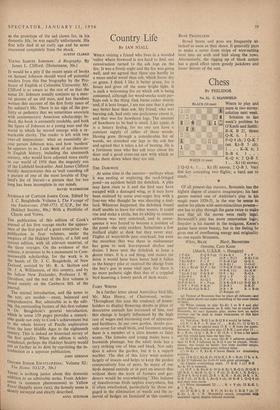Chess
By PHILIDOR
No. 32. C. MANSFIELD
BLACK (10 men) WHITE to play and mate in two moves: solution next week.
Solution to last week's problem by O'Keefe and Smith: R-K B 2!, threat Q-1( 6. 1 . . P-Q 4 ch; 2 Q-K 7 (set Kt-B 5 ch). I . • K-K 6; 2
R-B 4. 1 . K-Q 4; 2 Q-B 5. 1 ... Kt (4) moves; 2 Q-Q 4. 1 . . . Kt (8) moves; 2 Q-B 3. Very' fine key conceding two flights; a hard nut to crack.
Of all present-day masters, Bronstein has the highest degree of creative imagination; his best games remind one of Alekhine's play in his magic years 1929-31, in the way he seems to endow his pieces with semi-miraculous powers— one has to play through the game twice to make sure that all the moves were really legal. Botwinnik's play has more remorseless logic; Smyslov is his master in the endgame, Keres's games have more beauty, but in the feeling he gives one of overflowing energy and originality no one equals Bronstein.
White, BILEK Black, BRONSTEIN Opning, Caro Kann (Match, U.S.S.R. v. Hungary)
1 P-K4 P-Q B 3 (a) 13 Kt-K 2 P x P,
2 P-Q 4 P-Q 4 14 P x P(f) B-Kt 5 ch 3 Kt-Q B 3 P x P 15 K-B 2 (g) Q-K 2
4 Kt x P Kt-K B 3 16 B-Kt 2. 0-0-0
5 Kt x Kt ch Kt P x Kt 17 P-Q R 3? (h) B-Q B 41
6 P-B 3 B-8 4 18 B-K 3 (i) Kt- K 4!
7 Kt-K 2 (b) P-K R 4! '19 P x Kt R-Q 6 8 Kt-B 4 P-R 5 20 Q x P Q x Q 9 Q-I3 3 (c) Kt- Q 2 21 P x Q R x B 10 P-IC Kt 4 P x P e.p. 22 K R-Q B 1 (J) 13,Q Kt 3 11 BP x P (d) 41 23 B-B 3 B-K 5! 12 P-K Kt 4 (e) B-R 2 24 B x B R x Bch 25 Resigns (k) (a) Typical of Bronstein that he plays all defences—sad as this game shows can make something of the most dismal of them.
(b) White intends to play Kt-Kt 3 or B 4 and play against Black's weaknesses on IC side; but in typical style Bronstein, by very dynamic play, shows haw an UCUVC position can be used to make weaknesses of this kind unimportant. (c) Too slow. B-Q 3 or B-Q B 4 would be better.
(d) If 11 RP x P, then 11 . . . B-Kt 51; 12 Q-Kt 2, Kt-K 4!; can be played since 13 R x R. loses the queen. However, White could noW play 13 B-K 2 and after 13 ... It x ch; 14 Q x R., B x B; 15 K x B has a fair game and this would have been the best line.
(e) If 12 Kt-K 2 at once (Kt-lt 5 achieves nothing), then 12 B-K 3 followed by 13-Q 4 can be played. Never- theless, this would be better: text loses another tempo, since Black gets bishop away without delay. (1) 14 Kt x P, Kt-K 4 leaves Blacki nt dominating position.
(g) 15 13-Q 2, Kt-K 41; 16 Q-K 3, B X B eh; 17k x Q-Kt 3! followed by 0-0-0 with great advantage. (h) Clearly overlooking reply. 17 B-K 3 (17 B-B Kt-K 4!) is essential.
(1) 18 P x B, Kt-K 4; 19 Q-K Kt 3.11-Q 6; 20 Q-R 4 (20 B-K 3. Kt-B 5), Q x P oh; 21 K-K 1, K R-Q 1 ; 22 B-B 4, R-Q 8 chi; 23 R x R, R x R Oh; 24 K x R, Q-B 7 ch; 25 K-K L Kt-Q 6 ch; 26 K-B I, Q-Q 8 ch and mate next move. (J) White threatened 22 . . . R x ch; 23 K-K 1,- R eh. (k) 25 K-B 1, R R P; 26 Kt-Kt 3, R-B 7 cb; 27 K-Kt I, R x P. Wonderful attack, completed with unabated vigour despite reduced material.
WHITE (8 men)


































 Previous page
Previous page